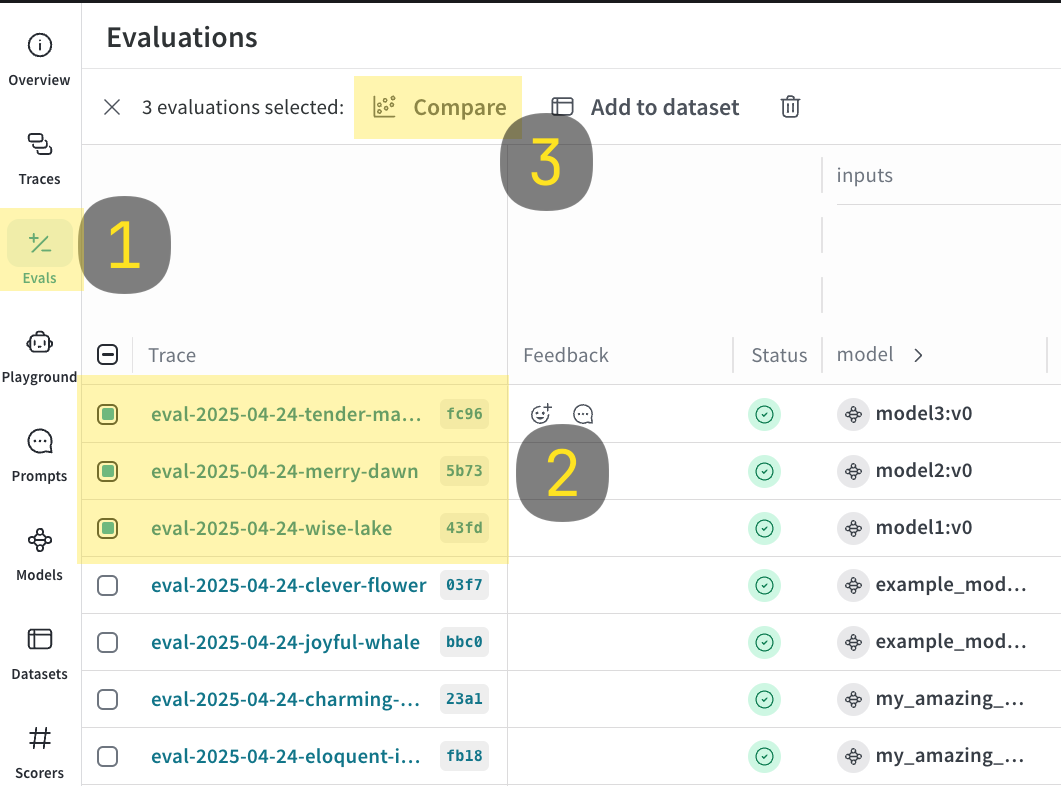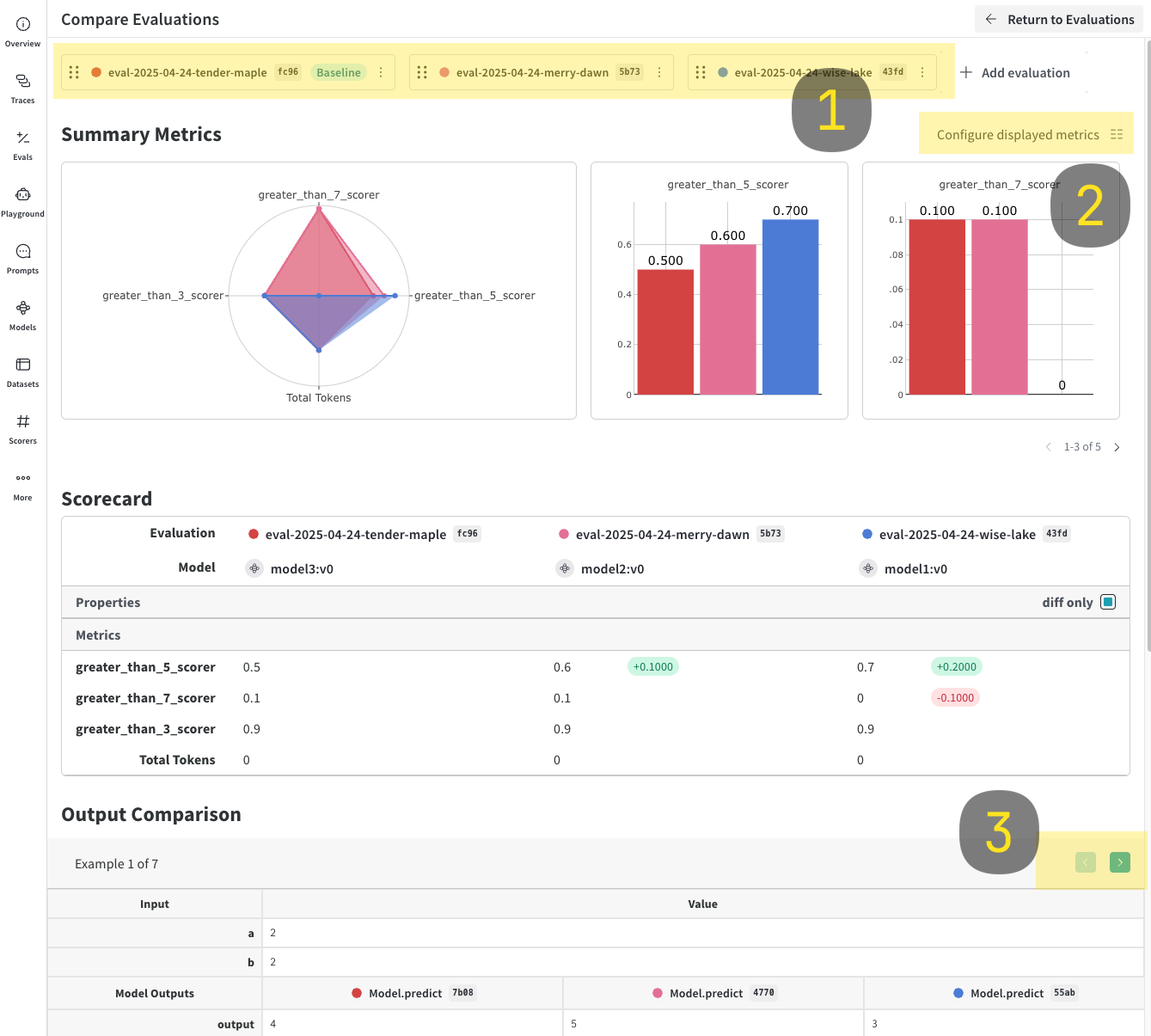EvaluationLogger
The EvaluationLogger provides a flexible, incremental way to log evaluation data directly from your Python code. You don't need deep knowledge of W&B Weave's internal data types; simply instantiate a logger and use its methods (log_prediction, log_score, log_summary) to record evaluation steps.
This approach is particularly helpful in complex workflows where the entire dataset or all scorers might not be defined upfront.
In contrast to the standard Evaluation object, which requires a predefined Dataset and list of Scorer objects, the EvaluationLogger allows you to log individual predictions and their associated scores incrementally as they become available.
If you prefer a more opinionated evaluation framework with predefined datasets and scorers, see Weave's standard Evaluation framework.
The EvaluationLogger offers flexibility while the standard framework offers structure and guidance.
Basic workflow
- Initialize the logger: Create an instance of
EvaluationLogger, optionally providing metadata about themodelanddataset. Defaults will be used if omitted.Track token usage and costTo capture token usage and cost for LLM calls (e.g. OpenAI), initialize
EvaluationLoggerbefore any LLM invocations**. If you call your LLM first and then log predictions afterward, token and cost data are not captured. - Log predictions: Call
log_predictionfor each input/output pair from your system. - Log scores: Use the returned
ScoreLoggertolog_scorefor the prediction. Multiple scores per prediction are supported. - Finish prediction: Always call
finish()after logging scores for a prediction to finalize it. - Log summary: After all predictions are processed, call
log_summaryto aggregate scores and add optional custom metrics.
After calling finish() on a prediction, no more scores can be logged for it.
For a Python code demonstrating the described workflow, see the Basic example.
Basic example
The following example shows how to use EvaluationLogger to log predictions and scores inline with your existing Python code.
The user_model model function is defined and applied to a list of inputs. For each example:
- The input and output are logged using
log_prediction. - A simple correctness score (
correctness_score) is logged vialog_score. finish()finalizes logging for that prediction. Finally,log_summaryrecords any aggregate metrics and triggers automatic score summarization in Weave.
import weave
from openai import OpenAI
from weave import EvaluationLogger
weave.init('my-project')
# Initialize EvaluationLogger BEFORE calling the model to ensure token tracking
eval_logger = EvaluationLogger(
model="my_model",
dataset="my_dataset"
)
# Example input data (this can be any data structure you want)
eval_samples = [
{'inputs': {'a': 1, 'b': 2}, 'expected': 3},
{'inputs': {'a': 2, 'b': 3}, 'expected': 5},
{'inputs': {'a': 3, 'b': 4}, 'expected': 7},
]
# Example model logic using OpenAI
@weave.op
def user_model(a: int, b: int) -> int:
oai = OpenAI()
response = oai.chat.completions.create(
messages=[{"role": "user", "content": f"What is {a}+{b}?"}],
model="gpt-4o-mini"
)
# Use the response in some way (here we just return a + b for simplicity)
return a + b
# Iterate through examples, predict, and log
for sample in eval_samples:
inputs = sample["inputs"]
model_output = user_model(**inputs) # Pass inputs as kwargs
# Log the prediction input and output
pred_logger = eval_logger.log_prediction(
inputs=inputs,
output=model_output
)
# Calculate and log a score for this prediction
expected = sample["expected"]
correctness_score = model_output == expected
pred_logger.log_score(
scorer="correctness", # Simple string name for the scorer
score=correctness_score
)
# Finish logging for this specific prediction
pred_logger.finish()
# Log a final summary for the entire evaluation.
# Weave auto-aggregates the 'correctness' scores logged above.
summary_stats = {"subjective_overall_score": 0.8}
eval_logger.log_summary(summary_stats)
print("Evaluation logging complete. View results in the Weave UI.")
Advanced usage
Get outputs before logging
You can first compute your model outputs, then separately log predictions and scores. This allows for better separation of evaluation and logging logic.
# Initialize EvaluationLogger BEFORE calling the model to ensure token tracking
ev = EvaluationLogger(
model="example_model",
dataset="example_dataset"
)
# Model outputs (e.g. OpenAI calls) must happen after logger init for token tracking
outputs = [your_output_generator(**inputs) for inputs in your_dataset]
preds = [ev.log_prediction(inputs, output) for inputs, output in zip(your_dataset, outputs)]
for pred in preds:
pred.log_score(scorer="greater_than_5_scorer", score=output > 5)
pred.log_score(scorer="greater_than_7_scorer", score=output > 7)
pred.finish()
ev.log_summary()
Log rich media
Inputs, outputs, and scores can include rich media such as images, videos, audio, or structured tables. Simply pass a dict or media object into the log_prediction or log_score methods:
import io
import wave
import struct
from PIL import Image
import random
from typing import Any
import weave
def generate_random_audio_wave_read(duration=2, sample_rate=44100):
n_samples = duration * sample_rate
amplitude = 32767 # 16-bit max amplitude
buffer = io.BytesIO()
# Write wave data to the buffer
with wave.open(buffer, 'wb') as wf:
wf.setnchannels(1)
wf.setsampwidth(2) # 16-bit
wf.setframerate(sample_rate)
for _ in range(n_samples):
sample = random.randint(-amplitude, amplitude)
wf.writeframes(struct.pack('<h', sample))
# Rewind the buffer to the beginning so we can read from it
buffer.seek(0)
# Return a Wave_read object
return wave.open(buffer, 'rb')
rich_media_dataset = [
{
'image': Image.new(
"RGB",
(100, 100),
color=(
random.randint(0, 255),
random.randint(0, 255),
random.randint(0, 255),
),
),
"audio": generate_random_audio_wave_read(),
}
for _ in range(5)
]
@weave.op
def your_output_generator(image: Image.Image, audio) -> dict[str, Any]:
return {
"result": random.randint(0, 10),
"image": image,
"audio": audio,
}
ev = EvaluationLogger(model="example_model", dataset="example_dataset")
for inputs in rich_media_dataset:
output = your_output_generator(**inputs)
pred = ev.log_prediction(inputs, output)
pred.log_score(scorer="greater_than_5_scorer", score=output["result"] > 5)
pred.log_score(scorer="greater_than_7_scorer", score=output["result"] > 7)
ev.log_summary()
Log and compare multiple evaluations
With EvaluationLogger, you can log and compare multiple evaluations.
- Run the code sample shown below.
- In the Weave UI, navigate to the
Evalstab. - Select the evals that you want to compare.
- Click the Compare button. In the Compare view, you can:
- Choose which Evals to add or remove
- Choose which metrics to show or hide
- Page through specific examples to see how different models performed for the same input on a given dataset
import weave
models = [
"model1",
"model2",
{"name": "model3", "metadata": {"coolness": 9001}}
]
for model in models:
# EvalLogger must be initialized before model calls to capture tokens
ev = EvaluationLogger(model=model, dataset="example_dataset")
for inputs in your_dataset:
output = your_output_generator(**inputs)
pred = ev.log_prediction(inputs=inputs, output=output)
pred.log_score(scorer="greater_than_3_scorer", score=output > 3)
pred.log_score(scorer="greater_than_5_scorer", score=output > 5)
pred.log_score(scorer="greater_than_7_scorer", score=output > 7)
pred.finish()
ev.log_summary()


Usage tips
- Call
finish()promptly after each prediction. - Use
log_summaryto capture metrics not tied to single predictions (e.g., overall latency). - Rich media logging is great for qualitative analysis.